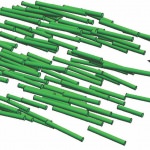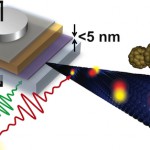Tag Materials science
Computer-generated database of diffusion values is shared online
University of Wisconsin–Madison engineers recently used powerful computers to quickly and accurately develop the world’s largest computed database of information about an important materials-mixing process called diffusion.
New nanogenerator harvests power from rolling tires
A group of University of Wisconsin–Madison engineers and a collaborator from China have developed a nanogenerator that harvests energy from a car's rolling tire friction.
Carbon nanotube finding could lead to flexible electronics with longer battery life
University of Wisconsin–Madison materials engineers have made a significant leap toward creating higher-performance electronics with improved battery life — and the ability to flex and stretch. Led by materials science Associate Professor Michael Arnold and Professor Padma Gopalan, the team has reported the highest-performing carbon nanotube transistors ever demonstrated. In addition to paving the way for improved consumer electronics, this technology could also have specific uses in industrial and military applications.
Vibration energy the secret to self-powered electronics
A multi-university team of engineers has developed what could be a promising solution for charging smartphone batteries on the go - without the need for an electrical cord.
With new high-tech materials, UW–Madison researchers aim to catalyze U.S. manufacturing future
Drawing on methods similar to those used to sequence the human genome, a multi-university team of researchers aims to discover and create revolutionary advanced materials that could help solve grand challenges in such areas as energy, national security and human health.
In static friction, chemistry is key to stronger bonds
Inspired by phenomena common to both earthquakes and atomic force microscopy, University of Wisconsin–Madison materials engineers have learned that chemical reactions between two silicon dioxide surfaces cause the bonds at that interface to "age," or strengthen gradually over time.
Curiosities: Is anything harder than diamond?
People have made that claim, but the verdict is not in, says Don Stone, a professor of materials science and engineering at the University of…
Curiosities: What is the flattest thing in the world?
The answer depends on many factors, including how the measurement is made and the scale of interest. “A mountain can look very rough, but if…
Template engineering demonstrates possibilities of new superconducting material
A breakthrough approach by University of Wisconsin–Madison researchers and their collaborators in fabricating thin films of a new superconducting material has yielded promising results: The material has a current-carrying potential 500 times that of previous experiments, making it significant for a variety of practical applications.
New approach could produce multifunction nanodevices
A team led by University of Wisconsin–Madison researchers has developed a new approach for creating powerful nanodevices, and their discoveries could pave the way for other researchers to begin more widespread development of these devices.
Silicon superlattices: New waves in thermoelectricity
A University of Wisconsin–Madison research team has developed a new method for using nanoscale silicon that could improve devices that convert thermal energy into electrical energy.
Models present new view of nanoscale friction
To understand friction on a very small scale, a team of University of Wisconsin–Madison engineers had to think big.
Green highways: Research targets environmentally friendly asphalts
For those hoping to create a greener world, our country's millions of miles of asphalt roads may seem like an odd place to seek solutions. Yet, it's precisely because asphalt is so common that we have much to gain from making it more eco-friendly, says University of Wisconsin–Madison civil engineering professor Hussain Bahia.
Mother-of-pearl: Classic beauty and remarkable strength
While the shiny material of pearls and abalone shells has long been prized for its iridescence and aesthetic value in jewelry and decorations, scientists admire mother-of-pearl for other physical properties as well.
Hidden gems: New composites are stiffer than diamond
Using a unique combination of barium titanate and tin, University of Wisconsin–Madison researchers have made the first known material that's stiffer than diamond.











